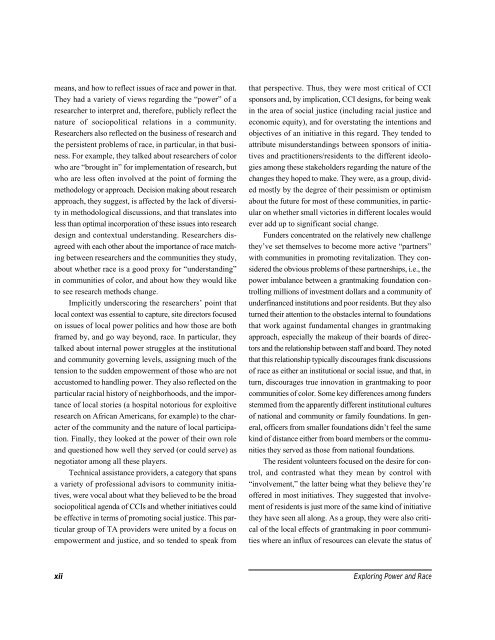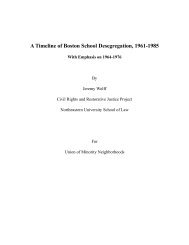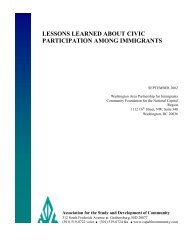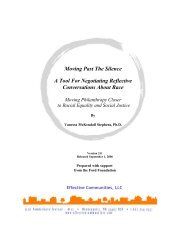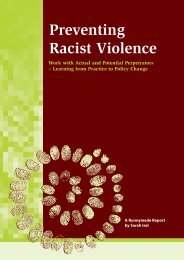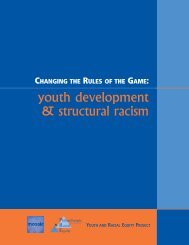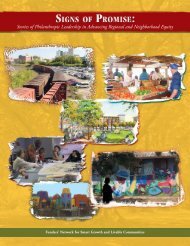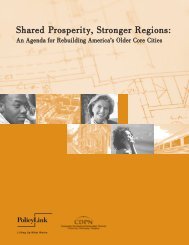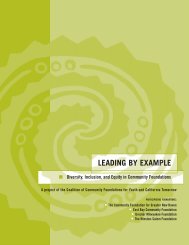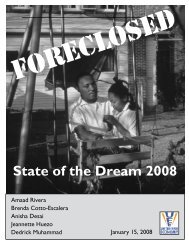Core Issues in Comprehensive Community-Building Initiatives ...
Core Issues in Comprehensive Community-Building Initiatives ...
Core Issues in Comprehensive Community-Building Initiatives ...
Create successful ePaper yourself
Turn your PDF publications into a flip-book with our unique Google optimized e-Paper software.
means, and how to reflect issues of race and power <strong>in</strong> that.<br />
They had a variety of views regard<strong>in</strong>g the “power” of a<br />
researcher to <strong>in</strong>terpret and, therefore, publicly reflect the<br />
nature of sociopolitical relations <strong>in</strong> a community.<br />
Researchers also reflected on the bus<strong>in</strong>ess of research and<br />
the persistent problems of race, <strong>in</strong> particular, <strong>in</strong> that bus<strong>in</strong>ess.<br />
For example, they talked about researchers of color<br />
who are “brought <strong>in</strong>” for implementation of research, but<br />
who are less often <strong>in</strong>volved at the po<strong>in</strong>t of form<strong>in</strong>g the<br />
methodology or approach. Decision mak<strong>in</strong>g about research<br />
approach, they suggest, is affected by the lack of diversity<br />
<strong>in</strong> methodological discussions, and that translates <strong>in</strong>to<br />
less than optimal <strong>in</strong>corporation of these issues <strong>in</strong>to research<br />
design and contextual understand<strong>in</strong>g. Researchers disagreed<br />
with each other about the importance of race match<strong>in</strong>g<br />
between researchers and the communities they study,<br />
about whether race is a good proxy for “understand<strong>in</strong>g”<br />
<strong>in</strong> communities of color, and about how they would like<br />
to see research methods change.<br />
Implicitly underscor<strong>in</strong>g the researchers’ po<strong>in</strong>t that<br />
local context was essential to capture, site directors focused<br />
on issues of local power politics and how those are both<br />
framed by, and go way beyond, race. In particular, they<br />
talked about <strong>in</strong>ternal power struggles at the <strong>in</strong>stitutional<br />
and community govern<strong>in</strong>g levels, assign<strong>in</strong>g much of the<br />
tension to the sudden empowerment of those who are not<br />
accustomed to handl<strong>in</strong>g power. They also reflected on the<br />
particular racial history of neighborhoods, and the importance<br />
of local stories (a hospital notorious for exploitive<br />
research on African Americans, for example) to the character<br />
of the community and the nature of local participation.<br />
F<strong>in</strong>ally, they looked at the power of their own role<br />
and questioned how well they served (or could serve) as<br />
negotiator among all these players.<br />
Technical assistance providers, a category that spans<br />
a variety of professional advisors to community <strong>in</strong>itiatives,<br />
were vocal about what they believed to be the broad<br />
sociopolitical agenda of CCIs and whether <strong>in</strong>itiatives could<br />
be effective <strong>in</strong> terms of promot<strong>in</strong>g social justice. This particular<br />
group of TA providers were united by a focus on<br />
empowerment and justice, and so tended to speak from<br />
that perspective. Thus, they were most critical of CCI<br />
sponsors and, by implication, CCI designs, for be<strong>in</strong>g weak<br />
<strong>in</strong> the area of social justice (<strong>in</strong>clud<strong>in</strong>g racial justice and<br />
economic equity), and for overstat<strong>in</strong>g the <strong>in</strong>tentions and<br />
objectives of an <strong>in</strong>itiative <strong>in</strong> this regard. They tended to<br />
attribute misunderstand<strong>in</strong>gs between sponsors of <strong>in</strong>itiatives<br />
and practitioners/residents to the different ideologies<br />
among these stakeholders regard<strong>in</strong>g the nature of the<br />
changes they hoped to make. They were, as a group, divided<br />
mostly by the degree of their pessimism or optimism<br />
about the future for most of these communities, <strong>in</strong> particular<br />
on whether small victories <strong>in</strong> different locales would<br />
ever add up to significant social change.<br />
Funders concentrated on the relatively new challenge<br />
they’ve set themselves to become more active “partners”<br />
with communities <strong>in</strong> promot<strong>in</strong>g revitalization. They considered<br />
the obvious problems of these partnerships, i.e., the<br />
power imbalance between a grantmak<strong>in</strong>g foundation controll<strong>in</strong>g<br />
millions of <strong>in</strong>vestment dollars and a community of<br />
underf<strong>in</strong>anced <strong>in</strong>stitutions and poor residents. But they also<br />
turned their attention to the obstacles <strong>in</strong>ternal to foundations<br />
that work aga<strong>in</strong>st fundamental changes <strong>in</strong> grantmak<strong>in</strong>g<br />
approach, especially the makeup of their boards of directors<br />
and the relationship between staff and board. They noted<br />
that this relationship typically discourages frank discussions<br />
of race as either an <strong>in</strong>stitutional or social issue, and that, <strong>in</strong><br />
turn, discourages true <strong>in</strong>novation <strong>in</strong> grantmak<strong>in</strong>g to poor<br />
communities of color. Some key differences among funders<br />
stemmed from the apparently different <strong>in</strong>stitutional cultures<br />
of national and community or family foundations. In general,<br />
officers from smaller foundations didn’t feel the same<br />
k<strong>in</strong>d of distance either from board members or the communities<br />
they served as those from national foundations.<br />
The resident volunteers focused on the desire for control,<br />
and contrasted what they mean by control with<br />
“<strong>in</strong>volvement,” the latter be<strong>in</strong>g what they believe they’re<br />
offered <strong>in</strong> most <strong>in</strong>itiatives. They suggested that <strong>in</strong>volvement<br />
of residents is just more of the same k<strong>in</strong>d of <strong>in</strong>itiative<br />
they have seen all along. As a group, they were also critical<br />
of the local effects of grantmak<strong>in</strong>g <strong>in</strong> poor communities<br />
where an <strong>in</strong>flux of resources can elevate the status of<br />
xii<br />
Explor<strong>in</strong>g Power and Race


